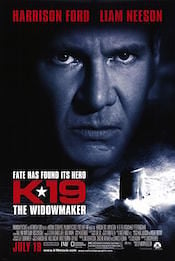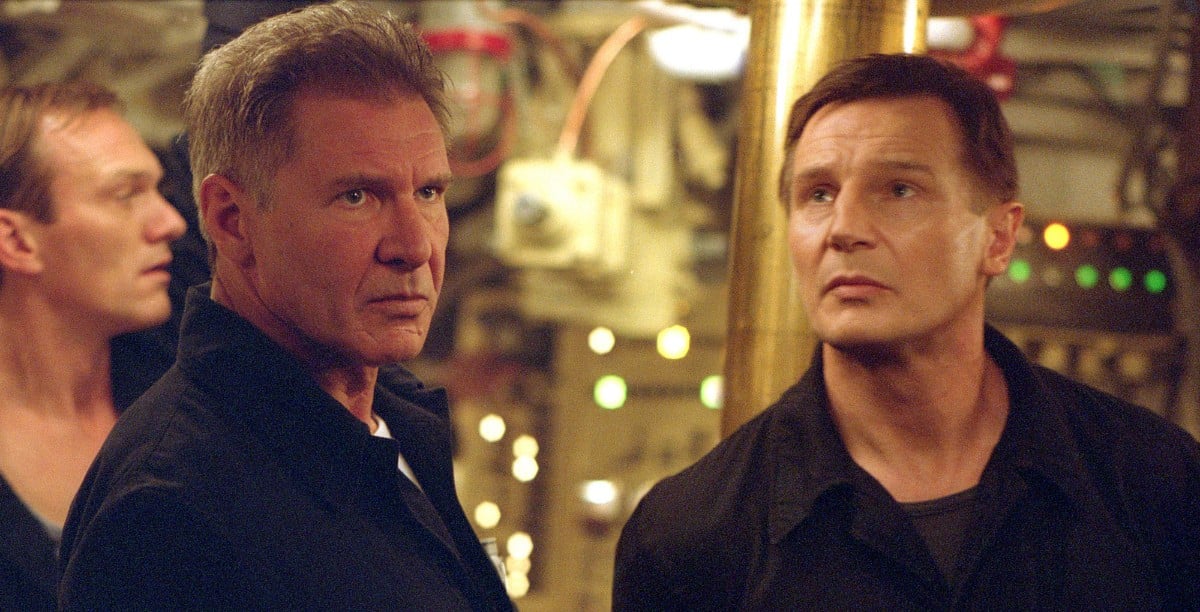K-19: The Widowmaker
 Rate Movie[Total: 9 Average: 3.4]
Rate Movie[Total: 9 Average: 3.4]
- Directed By: Kathryn Bigelow
- Written By: Louis Nowra, Christopher Kyle
- Release Date: July 19, 2002
- Domestic Distributor: Paramount
- Cast: Harrison Ford, Liam Neeson, Peter Sarsgaard

Box Office Info:
| Budget: $100 million | Financed by: Intermedia |
|---|---|
| Domestic Gross: $35,168,966 | Overseas Gross: $30,547,160 |

K-19: The Widowmaker was originally setup at Working Title, but they put the project into turnaround after their parent company Universal greenlit another submarine thriller U-571. Director Kathryn Bigelow then went off to helm The Weight Of Water after development stalled on K-19.
The project was moved over to the German based Intermedia, which financed the big budget K-19: The Widowmaker for $100 million. The budget put such a dent in their bottom line, that they were spending more than they were making and Intermedia posted a €11.9 million loss in 2001 on upfront costs on the production. There would be a lot more red ink to follow after this posted disastrous worldwide numbers. Intermedia also set up the movie’s finances in a way that would be near impossible for the company to recoup their investment — beginning with Harrison Ford’s $25 million salary, plus 20% of the gross.
To offset the expensive budget, worldwide rights were sold to distributors and K-19: The Widowmaker sold well. Regency was set to distribute the picture in the US through their distribution agreement with FOX, but Regency would not agree to Intermedia’s terms. Paramount then boarded K-19 for domestic distribution and gave Intermedia more of the share of box office receipts in return for covering a small portion of Paramount’s risk. To get a larger share of the backend, Intermedia would backstop and repay Paramount for any P&A expenses that the theatrical receipts would not cover — certainly they misjudged this movie’s appeal. Intermedia reported that if the film reached $60 million in domestic theatrical receipts, they would be $8 million short of recouping their costs.
K-19: The Widowmaker opened on July 19 against Stuart Little 2 and Eight Legged Freaks and reviews were mixed. It performed very poorly, coming in #4 for the weekend with $12,778,459 in 2,828 theaters. The film declined 43.1% in its second frame to $7,266,631 and then collapsed 60.7% in its third to $2,854,111 when Signs took most of the box office to itself. K-19: The Widowmaker closed with only $35,168,966 — almost half of what Intermedia expected the pic to post as a lowball estimate. About $19.3 million would be returned after theaters take their percentage of the gross, which would not cover the P&A expenses — plus 20% went to Ford and Paramount also landed a distributor fee.
Before Paramount took on US distribution, they scooped up rights in the UK, France, Australia and New Zealand and the movie posted a miserable $1,096,297 in the UK, $1,460,664 from France, just $805,997 from Australia and $209,992 from New Zealand. The overseas total was a terrible $30.5 million across numerous distributors. K-19: The Widowmaker ended as a loss near $100 million.
Kathryn Bigelow saw her long delayed The Weight Of Water barely get a theatrical release about three months after this flopped. K-19 marked a downward trend for Harrison Ford’s two decades of reliability at the box office. He followed this with Hollywood Homicide (2003), which also ended as one of the biggest bombs in movie history and then he remained offscreen until the flop Firewall (2006).

was released by Paramount Pictures on July 19, 2002 in the United States while on September 5, 2002 in Germany and October 25, 2002 in the United Kingdom. Upon release, the film received generally mixed reviews from critics, which particularly praised the performances and the dramatic atmosphere but criticized the screenwriting. In addition to criticial disappointment, the film became a box office failure grossing $65 million against a production budget of $90 million.
“The film was not financed by a major studio (National Geographic was owned by National Geographic Partners, a joint venture with 21st Century Fox and The National Geographic Society), making it one of the most expensive independent films to-date.”